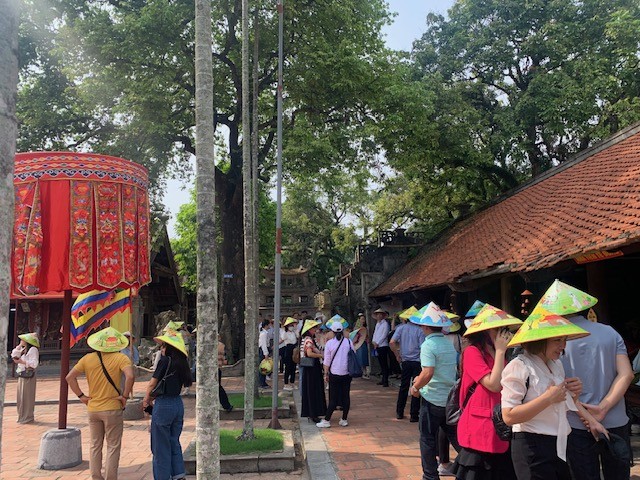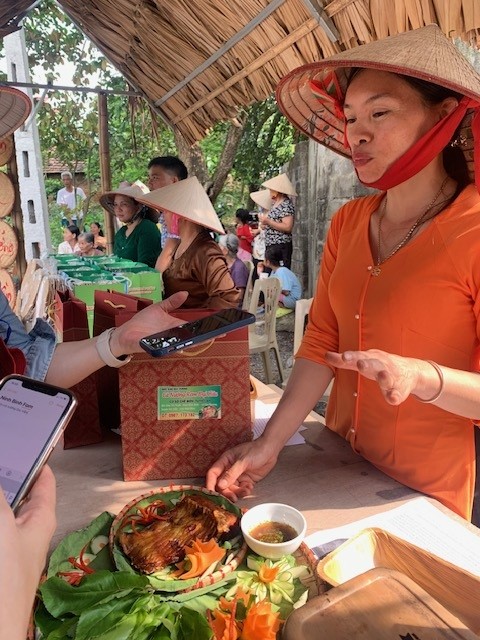
Tracing Vietnamese historical and cultural roots in Saint Nguyen Temple
Latest
Located in Gia Thang commune and Gia Tien commune (Gia Vien district, Ninh Binh province), Saint Nguyen Temple is an ancient temple that worships Zen Master Nguyen Minh Khong, the head of the Buddhist organization of the Ly dynasty, honored by King Ly Nhan Tong as the National Master. More specifically, this temple was ranked as a national architectural and artistic relic in 1989.
 |
| Local tourists visit Saint Nguyen Temple. (Photo: Phuong Linh) |
Prominent National Master of Ly dynasty
Zen Master Nguyen Minh Khong’s full name is Nguyen Chi Thanh (1073-1141), a native of Diem Xa village, part of the ancient Trang An district.
According to legend, Master Nguyen Minh Khong was the head monk of the Ly dynasty in Vietnamese history, as well as the first person to apply treatment methods with Vietnamese herbs and acupuncture.
In 1136, twenty-year-old King Ly Than Tong was cured of a serious illness by Zen Master Minh Khong. According to Mr. Pham Van Luu, who worked in the celebration committee of Saint Nguyen Temple, around 1121, Master Minh Khong returned to Dam Xa (his hometown) to build a small temple to worship Buddha, named Vien Quang Monastery to practice religion and save people.
Master Minh Khong was instrumental in spreading Buddhism, traveled throughout Dai Viet, built more than 500 pagodas, some of which are famous pagodas that still exist today, including ancient Bai Dinh Pagoda, Dich Long Pagoda, Non Nuoc Pagoda (Ninh Binh), Keo Pagoda (Thai Binh), Co Le Pagoda (Nam Dinh), and Kim Lien Pagoda (Hanoi).
He is also honored as the ancestor of bronze casting, and is solemnly worshiped in long-standing bronze casting villages in Nam Dinh, Ha Noi, Thanh Hoa, Hung Yen, and Bac Ninh.
In addition, he was the first person to cast the Buddha statue at Quynh Lam pagoda and cast the bronze top on the Bao Thien tower, two treasures in the "Four Great Treasures of An Nam" at that time.
In August 1141, he passed away, being venerated as the Great Saint. To commemorate his merits, people converted Vien Quang pagoda into a place to worship him.
 |
| The ancient temple was ranked as a national architectural and artistic relic in 1989. (Photo: Phuong Linh) |
Extraordinary ancient architecture
Located on a piece of land 100m long and more than 40m wide, Saint Nguyen Temple faces south, parallel to Tien Yet Street, towards the ancient capital of Hoa Lu, so it is considered a relic of the "Four sacred temples of Hoa Lu" (Hoa Lu tu tran).
The Temple has four buildings, typical architecture of the Later Le Dynasty, both harmonious and solemn. When entering the temple, the first thing that catches your eye is the gazebo (Vong Lau) built on the foundation of the Vien Quang pagoda that Nguyen Minh Khong founded.
The gazebo has open architecture so there are no doors. Both the front and back sides have Hoanh Phi paintings and ancient couplets. Besides, on the left side of the gazebo is a book tree and on the right side is a stone lamp, both in hexagonal shapes over 1 meter high placed on a stone pedestal, a symbol of wisdom.
Next is the 5-compartment Tien Bai building with four rows of columns, rounded and uncolored tile roof. In this building, there are 5 hammock doors with vermillion lacquered and gilded wood panels, and vivid images of two dragons flaking the moon, and four mythical creatures in Vietnamese culture. The upper middle space on the outside has a “horizontal plaque” (resembling a painting or picture, typically inscribed with Chinese characters, which are often hung above an altar) carved with 4 Chinese characters. The columns in the building are hung with numerous couplets praising the merits of Saint Nguyen Minh Khong.
The second building's architecture is imbued with unique folk architecture, the two intersecting roofs are similar in height, harmonious with each other.
The innermost is the five-compartment main sanctum in the style of 17th century sculpture art. Apart from precious ancient artifacts, the Temple also preserves 50 imperial edicts (refers to a document issued by the emperor to confer titles and ranks upon nobles and officials, commend individuals for their contributions, or honor deities) of the Le and Nguyen dynasties.
The temple's architecture demonstrates the skillful and talented hands of ancient artisans, integrating with the mountains, rivers, clouds, and sky in Hoa Lu Ancient Capital to create a unique artwork.
 |
| Local people introduce traditional local craft products to tourists. (Photo: Phuong Linh) |
“Tracing roots” tourism products
Visiting Saint Nguyen Temple, not only learn about historical culture, visitors can also experience the Sinh Duoc craft village, which is said to be where Saint Nguyen Minh Khong, during his practice, discovered medicinal herbs to cure the strange illness - “changing into a tiger” for King Ly Than Tong (thick hair appeared from his head to toe, he scratched and roared like a tiger for months).
With that desire, local people established a Cooperative that produces a full range of convenient products with natural origin, serving essential needs and taking care of human health by using traditional methods imbued with Vietnamese identity, such as soap, bath salt, soaking salt, toothpaste, and washing liquid.
With the medicine to save lives, Saint Minh Khong’s hometown is no longer famous for its traditional craft villages, such as rice paper craft village and bamboo and rattan weaving craft village.
Currently, Diem Giang rice paper craft village is also a tourist destination. Rice paper is handmade from the stages of soaking, grinding, pounding, rinsing, drying, creating quality products, ensuring food safety and hygiene standards, and aiming for local OCOP products.
The Saint Nguyen Temple Festival takes place for 3 days (from March 8 to 10 of the Lunar Calendar). This is an occasion for local people to honor Saint Nguyen Minh Khong, a son of Gia Vien land.
In particular, Gia Vien district has repaired and embellished several facilities to create unique beauty for the festival, including making bamboo lanterns, making paintings from bamboo and rattan products, or presenting rustic dishes like rice paper, plain rice flan (banh duc), muskmelons, and Dai Huu grilled fish.
The images and rustic flavors at the countryside market increasingly attract tourists from all over the world to the Saint Nguyen Temple Festival.

















